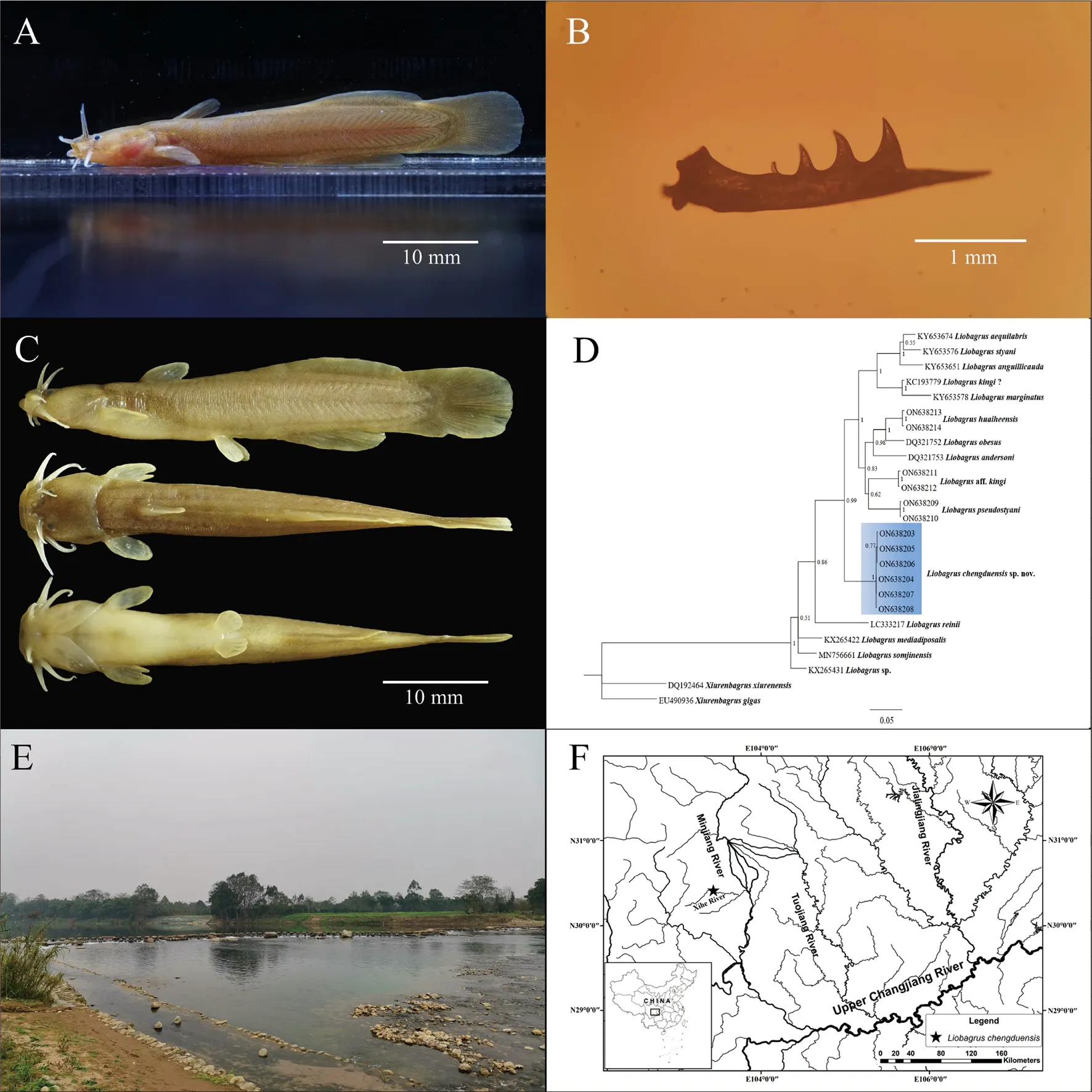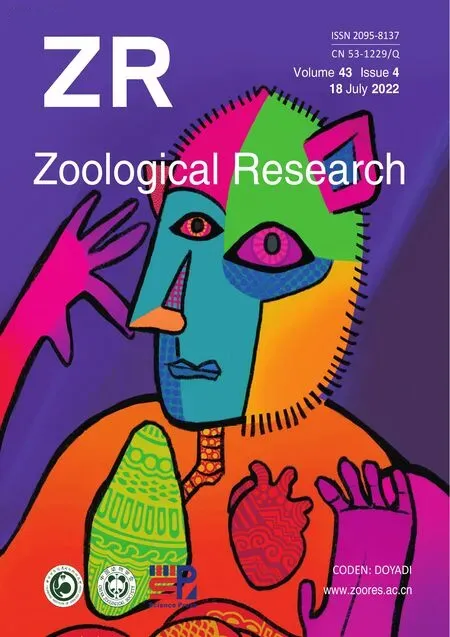Liobagrus chengduensis,a new species of torrent catfish (Teleostei:Siluriformes:Amblycipitidae) from the upper Changjiang River basin in southwest China
DEAR EDITOR,
A new torrent catfish species,Liobagrus chengduensissp.nov.,is described from the Xihe River,a tributary of the Minjiang River,Qionglai City,Chengdu City,Sichuan Province,China.It can be distinguished from all other congeneric species by a unique combination of the following characters:3–4 serrations on posterior edge of pectoral-fin spine;anal fin with 15–16 rays;upper jaw obviously shorter than lower jaw;caudal fin rounded,with 42–44 rays;vertebral column with 36–37 post-Weberian elements;anus close to pelvic-fin insertion;adipose fin posteriorly continuous with caudal fin,with marked incision at confluence;body generally brownish yellow;all fins lacking well-defined light-colored margins,with color fading towards edge.
The genusLiobagrusis a group of small freshwater catfish belonging to the family Amblycipitidae.So far,18 species ofLiobagrushave been described,10 of which are distributed in mainland China.The upper Changjiang River contains the highest diversity ofLiobagrusin China,with seven species recorded in this region:i.e.,L.marginatus,L.nigricauda,L.marginatoides,L.kingi,L.aequilabris,L.chenghaiensisandL.pseudostyani(Chen et al.,2021b;Ding,1994;He,1999;Sun et al.,2013;Xie,2017).
The Chengdu Plain,located in southwestern China,contains the Minjiang and Tuojiang rivers,which form an extensive water network with rich fish diversity.The region belongs to the upper Changjiang River basin and has a unique fish composition with many endemic species.In recent years,following in-depth investigations and field surveys,many new fish species,such asYunnanilus jiuchiensis,Rhodeus cyanorostris,Acheilognathus mengyangensis,andLiobagrus pseudostyani,have been discovered in this region (Chen &Guo,2021;Chen et al.,2021a;Du et al.,2018;Li et al.,2020).These discoveries indicate that fish diversity in the Chengdu Plain has not yet been fully explored.Based on a field survey conducted from January 2020 to January 2021 in the Xihe River,a tributary of the Minjiang River in Qionglai City,severalLiobagrusspecimens with a serrated posterior edge on the pectoral-fin spine were found,representing an undescribed species.
All nine specimens were collected from the Xihe River,a tributary of the Minjiang River,Qionglai City,Chengdu City,Sichuan Province,China.The specimens were collected by hand net and fish trap.The right pectoral fins of six specimens were fixed in 95% ethanol for DNA extraction.All specimens were fixed in 10% formalin and later transferred to 75%ethanol for long-term storage.Measurements were taken point-to-point with digital calipers recorded to the nearest 0.1 mm.Counts and measurements followed Hubbs &Lagler(1964).Vertebrae and anal-fin rays were detected and counted using micro-computed tomography (Quantum GX Ⅱ,PerkinElmer,USA).
Genomic DNA was extracted from pectoral fins preserved in 95% ethanol using an Animal Genomic DNA Kit (Tsingke,China).Phylogenetic relationships were studied using the cytbsequence amplified using primers L14724 (GACTTGA AAAACCACCGTTG) and H15915 (CTCCGATCTCCGGAT TACAAGAC).Polymerase chain reaction (PCR) amplifications of cytbwere performed in a final 23 μL volume mixture containing 1 μL of template DNA,1 μL of each pair of primers,and 20 μL of 1×T3 Super PCR Mix (Tsingke,China).Thermal cycling began with one cycle at 98 ℃ for 5 min,followed by 35 cycles of denaturation at 98 ℃ for 10 s,60 ℃ for 10 s,and 72 ℃ for 10 s,with a final extension step at 72 ℃ for 2 min.The PCR products were purified and sequenced using an ABI 3730XL analyzer by Tsingke Biological Technology (China).The accession numbers of 14 otherLiobagrusspecies and all newly obtained sequences are given in Supplementary Table S1.
Genes were aligned using MEGA v6 and checked by eye.Phylogenetic relationships were estimated using Bayesian inference (BI),with partitions based on genes and codon positions.Xiurenbagrus gigasandX.xiurenensiswere used as the outgroup for rooting the tree.PhyloSuite v1.2.2 was used for analysis and to determine the best-fit model(GTR+I+G) for sequence evolution.Trees were visualized in FigTree v.1.4.3 and PowerPoint 2016.
Institutional abbreviations include the following:College of Life Sciences,Sichuan Agricultural University,Ya’an,China(SAULS);Natural History Museum,London,UK (BMNH);Institute of Zoology,Chinese Academy of Sciences,Beijing,China (ASIZB);Chonbuk National University,Jeonju,South Korea (CNUC);Field Museum of Natural History,Chicago,USA (FMNH);Sichuan Academy of Forestry Sciences,Chengdu,China (SAFS);Institute of Hydrobiology,Chinese Academy of Sciences,Wuhan,China (IHB).
Taxonomy
Liobagrus chengduensis sp.nov.
Figure 1A–C;Supplementary Table S2
Holotype:SAULS 2104001,39.9 mm SL,Xihe River(N30°24'48",E103°26'15"),Qionglai City,Chengdu City,Sichuan Province,China,collected by Zhong-Guang Chen on 12 January 2021.
Paratypes:SAULS 2101001,41.0 mm SL,collected by Xin Liu on 15 January 2020;SAULS 2103001,45.7 mm SL,collected by Zhong-Guang Chen on 5 March 2021;SAULS 2101042–2101047,35.2–46.9 mm SL;collected by Zhong-Guang Chen on 12 January 2021;other information same as holotype.
Diagnosis:Liobagrus chengduensissp.nov.can be distinguished fromL.reinii,L.formosanus,L.styani,L.nantoensis,L.anguillicauda,L.marginatoides,andL.aequilabrisby pectoral-fin spine with serrated posterior edge(vs.pectoral-fin spine with smooth posterior edge).WhileLiobagrus chengduensissp.nov.,L.marginatus,L.nigricauda,L.kingi,L.chenghaiensis,L.huaiheensis,L.pseudostyani,L.andersoni,L.mediadiposalis,L.obesus,L.somjinensis,andL.hyeongsanensisare defined by pectoralfin spine with serrated posterior edge,the new species can be distinguished from all other species in this group by the following characteristics:upper jaw obviously shorter than lower jaw (vs.longer inL.mediadiposalis,L.somjinensis,L.hyeongsanensis,L.huaiheensis,andL.pseudostyani),analfin rays 15–16 (vs.11–14 inL.marginatus,9–12 inL.kingi,10–12 inL.chenghaiensis,and 13–14 inL.mediadiposalis),post-Weberian vertebrae 36–37 (vs.more than 37 inL.andersoni,L.mediadiposalis,L.obesus,L.somjinensis,andL.hyeongsanensis),caudal fin rounded (vs.subtruncate inL.marginatus,L.chenghaiensis,L.andersoni,L.mediadiposalis,andL.somjinensis),anus closer to pelvic-fin insertion than to anal-fin origin (vs.closer to anal-fin origin than to pelvic-fin insertion inL.kingi,L.andersoni,andL.obesus),marked incision present at confluence between adipose and caudal fin(vs.incision absent inL.nigricauda,L.hyeongsanensis,andL.pseudostyani),posterior margin of pectoral-fin spine not reaching dorsal-fin base (vs.reaching dorsal-fin base inL.marginatus,L.nigricauda,L.kingi,L.chenghaiensis,L.huaiheensis,L.andersoni,L.mediadiposalis,L.obesus,andL.somjinensis) (Supplementary Table S3).
Description:Morphometric data of holotype and paratypes are shown in Supplementary Table S2.Body elongated,anteriorly terete and posteriorly evenly compressed to tail.Lateral line short with 3–5 pores.Head depressed and broad when viewed dorsally.Snout broadly rounded in dorsal view.Anterior nostril tubular,rim with fleshy flap forming short tube;posterior nostril pore-like,rim posteriorly confluent with base of nasal barbel.Eye small,dorsolateral,and subcutaneous.Mouth terminal;upper jaw obviously shorter than lower jaw.Lips thickened.Premaxillary and mandibular tooth pads curved,with small and setiform teeth.Palatine teeth absent.Four pairs of barbels,maxillary barbel long,not extending to pectoral-fin insertion;nasal barbel short,not extending to gillmembrane margin;inner mandibular barbel approximately half of outer mandibular barbel length,not extending to pectoral-fin insertion;outer mental barbel longest,not extending to pectoral-fin insertion.Dorsal fin with II,5 rays,distal margin convex;tip of adpressed fins not reaching pelvic-fin insertion.Dorsal-fin spine covered with thick skin,straight,with smooth anterior and posterior margin,slightly longer than pectoral-fin spine.Adipose fin high,base longer than anal-fin base,confluent with caudal fin,forming marked incision at confluence.Pectoral fin with I,6 rays,origin at vertical through edge of operculum,partially covered by opercular membrane.Pectoral-fin spine short and sharp,with 3–4 large and retrorse serrations on posterior edge (Figure 1B),tip not reaching dorsal-fin insertion.Pelvic fin with i,5 rays;short,with adpressed tip not reaching anal-fin origin.Anal fin with 15–16 rays;distal margin rounded;tip of adpressed fin reaching beyond posterior edge of adipose fin.Anus closer to pelvic-fin insertion than to anal-fin origin.Caudal fin rounded,with 42–44 rays.Vertebral column with 36–37 post-Weberian elements.
Coloration:Body generally brownish yellow,fading to light yellow ventrally.All barbels gray.Dorsal,adipose,and caudal fins brownish yellow.Unlike most congeneric species,all fins lack well-defined light-colored edges.Fins dark at base,fading to lighter color towards edges (Figure 1A).
Distribution and ecology:Liobagrus chengduensissp.nov.is currently only known from the Xihe River,a tributary of the Minjiang River,Qionglai City,Chengdu City,Sichuan Province,China (Figure 1F).The new species is nocturnal and benthic and inhabits the bottom of upstream running waters with pebble substrates,together withL.aff.kingiandL.pseudostyani(Figure 1E),whileL.marginatusinhabits in the main stream of the Minjiang River.
Etymology:The species is named after Chengdu City,its type locality.The proposed Chinese name is “成都䱀” and the proposed English common name is Chengdu Torrent Catfish.
Genetic comparisons:The validity ofLiobagrus chengduensissp.nov.was supported by molecular phylogenetic analysis based on cytbsequences (Figure 1D).Liobagrus chengduensissp.nov.was located at the base of the phylogenetic tree ofLiobagrusspecies distributed in mainland China and formed a distinct lineage.The genetic distances betweenLiobagrus chengduensissp.nov.and other congeneric species ranged from 8.7% to 12.0%(Supplementary Table S4).

Figure 1 Living specimen,pectoral-fin spine,phylogenetic position,habitat,and sampling locality of Liobagrus chengduensis sp.nov.
Remarks:Species ofLiobagruscan be divided into two groups based on the presence of a smooth or serrated posterior edge of the pectoral-fin spine.Thus far,the group defined by the presence of a serrated posterior edge includes 11 species.Within this group,Liobagrus chengduensissp.nov.is most similar toL.hyeongsanensisbased on small body size,short pectoral-fin spine,and lack of well-defined light-colored edges on all fins,but they differ from each other based on presence of marked incision at confluence between adipose and caudal fin (vs.absent inL.hyeongsanensis) and upper jaw obviously shorter than lower jaw (vs.longer inL.hyeongsanensis).Liobagrus chengduensissp.nov.also resemblesL.nigricaudabased on the similar position of upper and lower jaws and caudal fin shape,but differs based on marked incision at confluence between adipose and caudal fins (vs.incision absent inL.nigricauda) and shorter pectoralfin spine with tip not reaching dorsal-fin insertion (vs.reaching inL.nigricauda).Liobagrus chengduensissp.nov.is similar toL.marginatus,L.kingi,L.chenghaiensis,L.andersoni,andL.obesusbased on similar positions of upper and lower jaws(upper jaw shorter or equal to lower jaw),but differs from these species based on the lack of well-defined light-colored edges on all fins (vs.edges light-colored).The new species also differs fromL.marginatus,L.chenghaiensis,andL.andersoniby caudal fin rounded (vs.caudal fin subtruncate)and fromL.kingiandL.obesusby anus closer to pelvic-fin insertion than to anal-fin origin (vs.closer to anal-fin origin than to pelvic-fin insertion).Liobagrus chengduensissp.nov.can be easily distinguished fromL.huaiheensis,L.mediadiposalis,andL.somjinensisby upper jaw obviously shorter than lower jaw (vs.upper jaw longer).The new species can be further distinguished fromL.huaiheensisby pectoral-fin spine 5.1%–6.6% SL (vs.6.7%–9.4% SL) and fromL.mediadiposalisandL.somjinensisby caudal fin rounded (vs.caudal fin subtruncate).
Typically,only one or two species ofLiobagrusare distributed in the same river basin.However,surveys conducted in the middle reaches of the Minjiang River have identified four species ofLiobagrus,three of which are found in the Xihe River.Based on body size and position of the upper and lower jaws,it is speculated that niche differentiation may have occurred among the three sympatric species.Notably,L.pseudostyaniis larger (>150 mm SL),with a longer upper jaw than lower jaw;L.aff.kingiis intermediate in size(~100 mm SL),with a slightly shorter (or equal) upper jaw than lower jaw;andLiobagrus chengduensissp.nov.is smaller(<50 mm SL),with an obviously shorter upper jaw than lower jaw.In addition toLiobagrus chengduensissp.nov.,L.pseudostyaniis also recently described,suggesting that species diversity ofLiobagrusin the Minjiang River basin remains to be explored.Even in small urban rivers of the Chengdu Plain,diverse species ofLiobagrusoccur.Thus,extensive exploration of small river fish resources in the Chengdu Plain should be strengthened in the future,which may lead to the discovery of yet-to-be-described species.
NOMENCLATURAL ACTS REGISTRATION
The electronic version of this article in portable document format will represent a published work according to the International Commission on Zoological Nomenclature (ICZN),and hence the new names contained in the electronic version are effectively published under that Code from the electronic edition alone (see Articles 8.5–8.6 of the Code).This published work and the nomenclatural acts it contains have been registered in ZooBank,the online registration system for the ICZN.The ZooBank LSIDs (Life Science Identifiers) can be resolved and the associated information can be viewed through any standard web browser by appending the LSID to the prefix http://zoobank.org/.
Publication LSID:
urn:lsid:zoobank.org:pub:7BDFDA66-CACB-4515-878E-4D838F 973D92
Nomenclatural act LSID:
urn:lsid:zoobank.org:act:9D80E4E2-B036-42BC-916D-CFCF10 7EEA2B
SCIENTIFIC FIELD SURVEY PERMISSION INFORMATION
Field collections followed the rules of the Fisheries Law of the People’s Republic of China.All activities conformed to the Laboratory Animal Guidelines for the Ethical Review of Animal Welfare (GB/T 35892-2018).
SUPPLEMENTARY DATA
Supplementary data to this article can be found online.
COMPETING INTERESTS
The authors declare that they have no competing interests.
AUTHORS’ CONTRIBUTIONS
Z.G.C.and Y.S.G.designed the study.Z.G.C.collected the specimens.Z.G.C.and Y.S.G.examined the specimens and performed morphological comparisons.Z.G.C.and J.Y.W.conducted molecular analysis.Z.G.C.,Y.S.G.,and A.X.W.prepared the manuscript.All authors read and approved the final version of the manuscript.
ACKNOWLEDGEMENTS
We thank associate researcher Jie Wang (Chengdu Institute of Biology,Chinese Academy of Sciences) and Dr.Cheng Shen (Chengdu Institute of Biology,Chinese Academy of Sciences) for providing micro-CT examination;Xin Liu(Sichuan Agricultural University) for presenting specimens;Wei Lei (Chengdu) and Yi Feng (Chengdu) for assistance in collecting specimens;and Zhi-Xian Sun (Institute of Zoology,Chinese Academy of Sciences) for photo retouching.
Zhong-Guang Chen1,Yan-Shu Guo2,Jia-Yun Wu1,An-Xiang Wen1,*
1College of Life Sciences,Sichuan Agricultural University,Ya’an,Sichuan625014,China
2Ecological Restoration and Conservation on Forest and Wetland Key Laboratory of Sichuan Province,Sichuan Academy of Forestry Sciences,Chengdu,Sichuan610081,China
*Corresponding author,E-mail:2960657740@qq.com
- Zoological Research的其它文章
- Towards a primate single-cell atlas
- Protein composition of extracellular vesicles from skin secretions of the amphibian Bombina maxima
- Chromosome-level genome assembly of the freshwater snail Bellamya purificata (Caenogastropoda)
- A new seamoth species of Pegasus (Syngnathiformes:Pegasidae) from the East China Sea
- Allele-specific expression analyses reveal immune divergences between ibex and goat species
- Importance of genetic data from type specimens:The questionable type locality of southern white-cheeked gibbon,Nomascus siki (Delacour,1951)

